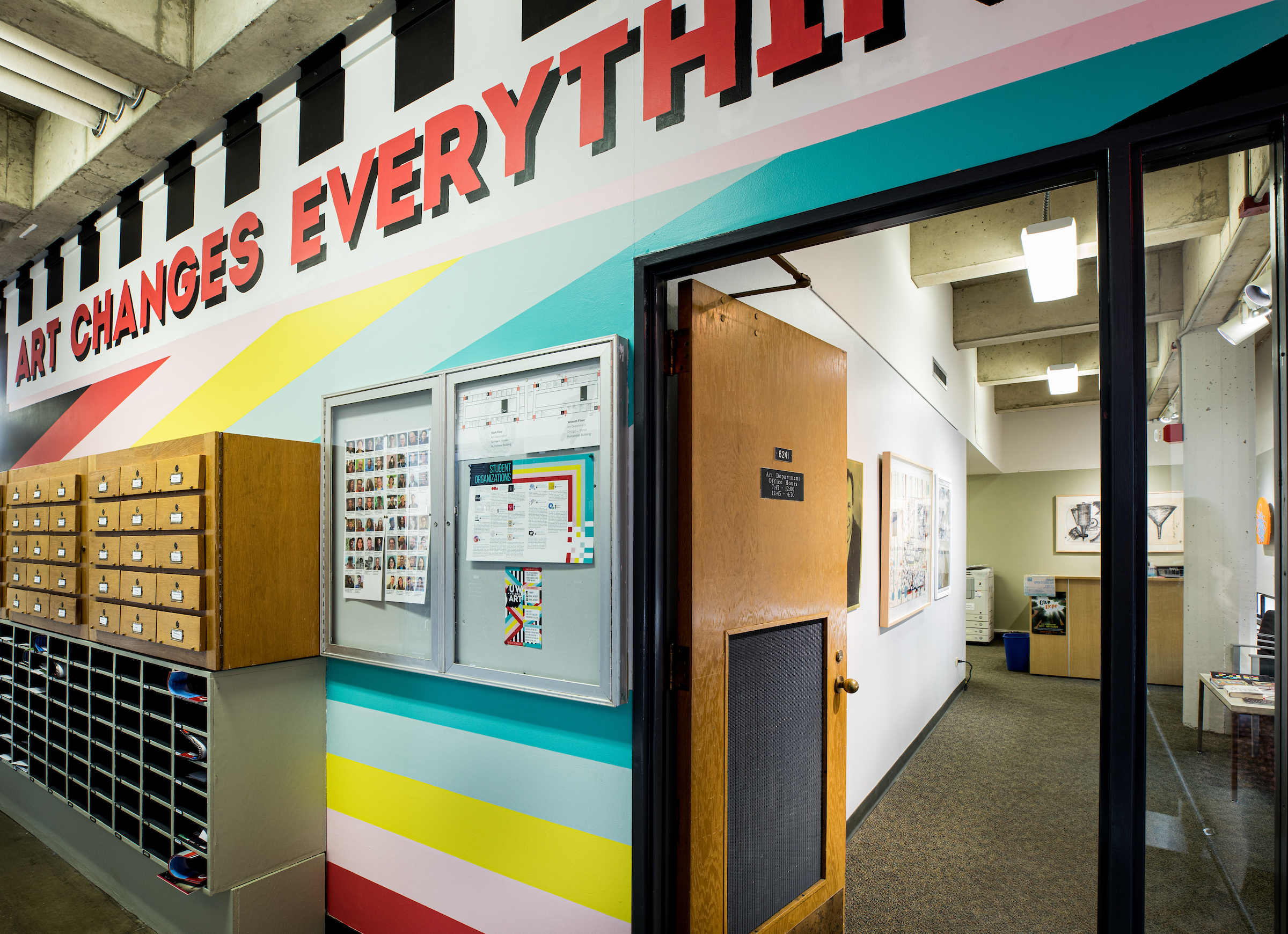The University of Wisconsin-Madison’s Art Department offers two professional programs, Studio Art and Art Education, across three undergraduate degrees and two studio certificate programs.
Studio Art majors may pursue either the Bachelor of Science in Art degree (BS-Art), the Bachelor of Fine Arts degree (BFA), or Graphic Design options in either degree. Art Education majors receive the Bachelor of Science in Art Education degree (BS-Art Ed) and eligibility for licensure to teach in elementary and secondary schools.
All art majors complete a Foundations year which includes courses in modern and contemporary art, drawing concepts and methods, and both analog and digital design for two, three and four-dimensional art practices. Students may select their breadth and elective studio courses from a list of incredibly diverse studio offerings offered by one of the most comprehensive programs in the country.
All of our undergraduate programs attract students who excel artistically as well as academically, and who upon graduation ultimately become leaders in whatever field they enter.

Matt Mauk, Academic Program Manager
mmauk@wisc.edu
BFA
- Foundations courses & first-year interest group (Art FIG)
- Bachelor of Fine Arts Program
The Bachelor of Fine Arts is the most studio-intensive, professional-level degree for artists and designers. Approximately 44 of the 72 required studio credits are spent in intermediate and advanced-level studio courses, allowing art and design students to graduate with a highly advanced portfolio. Most art majors decide to follow this degree path during their sophomore or junior years. With excellent planning and time management, this degree can be completed in four years.
BFA: Graphic Design Named Option
The BFA Graphic Design named option requirements listed here are components of the BFA – Art degree requirements, completing a total of 126 credits including at least 36 credits of major studio coursework and 18 aesthetics credits with four required courses. The remaining credits will be met by selecting from a list of aesthetics electives.
BFA Process
BFA Track Entry Requirements
- Junior or Senior status
- Minimum GPA of 2.5
- Completion of Studio Breadth courses (2D, 3D, Intermedia Arts, Graphics)
- Submit a BFA portfolio and statement through SlideRoom
- Take part in the BFA Mentoring Meeting
BFA (Portfolio) Submission Process
SlideRoom applications will open at the beginning of the month throughout the academic year and students will have until the end of the month to submit a portfolio of 10-12 images and a brief written statement about the artwork.
BFA submissions will close at the end of the month and students will be paired with faculty to review their work in the following month.
- If a portfolio is submitted in September, a faculty mentor will schedule an appointment for October, submissions in October will be scheduled for a meeting in November, and so on.
Students will book a portfolio mentoring appointment through Doodle Booking linked to individual BFA Committee Member schedules. These appointments might be in-person or virtual depending on the availability of the faculty member.
BFA Mentoring Meeting
BFA Committee Members will meet with students to discuss their thoughts and comments from the review process of the portfolio.
Students will be provided with suggestions such as artists to research, readings that might interest them, future goals, and other questions that require expertise in the field.
The Faculty member will then email the major advisor once the meeting is complete.
After the advisor is notified, the BFA candidate will be provided with the major change form.
The BFA SlideRoom page can be found here.
BS-Art
- Foundations courses & first-year interest group (Art FIG)
- Bachelor of Science in Art Program
Approximately 17 of the 45 required studio credits for a Bachelor of Science in Art are spent in intermediate and advanced-level studio courses, allowing students to graduate with a high-intermediate level portfolio. The smaller number of studio credits required in the BS-Art degree affords the flexibility for students to pursue second majors, certificates, or simply take more courses in other areas of academic interest. This degree can be completed in four years.
BS-Art: Graphic Design Named Option
The BS-Art Graphic Design named option requirements are components of the B.S. Art degree requirements completing a total of 120 credits, including a minimum of 45 studio credits.
BS-Art Education
Our undergraduate art education major provides essential preparation for careers in art education. Graduates of our program earn a Bachelors of Science degree, a Wisconsin teaching license in K–12 art education, and gain the skills, knowledge and confidence to teach the visual arts in public and private schools, at the elementary and secondary levels, and in community settings such as art museums, maker spaces and senior centers. Find a variety of art education-oriented jobs, internships and volunteer opportunities in the Madison area. Contact Art Education Program Coordinator Mary Hoefferle for advising and more information.
Foundations
The Art Foundations Program is a series of related studio and lecture courses to be taken by Art and Art Education majors in their first year as preparation for further study in studio art and design. The program addresses the fundamentals of art through investigation of formal, technical and conceptual issues. The Drawing, 2D and 3D design, Digital Media, and art historical lecture classes are designed to expose, broaden, and challenge students’ understanding of contemporary art production. The classes are meant to be taken concurrently and the information covered in them is interrelated, creating a network of corresponding experiences and a peer community that will continue throughout the program and beyond.
Art FIG
Most freshman Art majors complete their foundations courses through participation in the Art and Artists First-Year Interest Group (FIG). FIGs are learning communities designed specifically for first-year students at the University of Wisconsin-Madison. Sophomore students new to art are also included in the Art FIG. FIGs are a unique cluster of UW courses, linked together to explore a common theme or topic. Most FIGs are limited to only 20 students and students enroll in all of the course cluster as a set. This forms the basis of their “cohort” or “interest group.” The purpose of the FIGs Program is to provide an interesting, intimate, and interdisciplinary experience that helps students make a successful academic and social transition to the university.
Incoming freshman Art majors are strongly encouraged to participate in the Art FIG by enrolling in reserved sections of ART 102, 108 and 212 during the Fall semester and ART 104, 107 and 208 in the Spring.
FIG: BENEFITS
Make friends: Studying together and helping each other, you’ll get to know the students in your FIG well, making your first campus year easier.
Better learning: Integrating ideas from different courses will help you learn in a more interesting and holistic way.
Proven popularity: One of every five UW freshman enrolls in a FIG.
Studio Offerings
Students complete a rigorous Foundation program prior to branching out into one or more specialized area such as ceramics, cultural studies, digital art, drawing, glass working, graphic design, metalworking/jewelry, painting, performance, photography, all types of printmaking, theory, video, and woodworking. Literacy in, and mastery of, a chosen area of focus enables our students to become leaders in numerous creative fields as art educators, graphic and media designers, photographers, entertainment industry professionals, artisan specialists, community arts directors, as well as world-class fine artists.
Philosophy
The programs in the Art Department allow students to build on existing academic and technical abilities while fostering a thorough understanding of the societal and cultural conditions underscoring the current creative landscape. Students enjoy the close-knit atmosphere of a department that prides itself on having a very low teacher-to-student ratio, with an average class size of 8-10 students.
